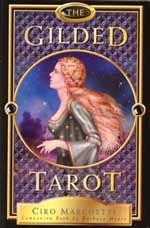
The Gilded Tarot
by Ciro Marchetti
pub. Llewellyn
reviewed by: David Bruce Albert Jr., Ph.D.,
[email protected]
In recent years, the Tarot community has
enjoyed an explosion of many new decks. Some of these are
magnificent works of art, other explore varied and unusual themes, and
many simply rehash familiar themes and imagery with different artistic
interpretations. Once in a while, however, a Tarot deck comes
along that not only dazzles with new and exciting artwork, but also
challenges tradition with new interpretations and brilliant
symbolism. These decks are so well researched and illustrated
that they cannot be ignored or dismissed as mere novelties; they demand
attention, they to some extent redefine what the Tarot is, and they
force one to examine what one's own ideas about the Tarot are.
One of the first decks to challenge the Golden Dawn and Marseilles
traditions was the Voyager Tarot. Its bold and exciting
photocollage imagery and strong New Age themes not only broke with the
cabalistic “standard,” however faithful or otherwise to the Cabala that
standard really is, but opened the door of the Tarot to many who felt
no attraction to the existing Tarot motifs. More recently, the
Sacred Circle Tarot has brought Celtic tradition and imagery to the
Tarot in a way that changes one’s basic understanding of the Oracle
itself, at least for those who are drawn to it. More than just a
recasting of the standard images and interpretations as so many
“Celtic” decks are, the Sacred Circle is a fundamental
re-interpretation of the Tarot itself within the framework of Celtic
myth, legend and belief. It is a major leap out of the Golden
Dawn tradition, into the world of Celtic mysticism.
 And now, we have the Gilded Tarot,
by Ciro Marchetti. “Welcome To
An Ancient World Of Magic And Wonder,” proclaims the box in which the
deck comes. Yes indeed, welcome to the mystery, beauty, and
wonder that the Tarot is and always should have been.
Finally, a deck conceived and executed by an artist with the
imagination to see within the tradition what its founders never saw,
and the talent to present images that are enchanting and inspiring --
images that provoke, rather than subdue, imagination and
curiosity. If I were going to teach the Tarot, this is the deck I
would use, no contest.
And now, we have the Gilded Tarot,
by Ciro Marchetti. “Welcome To
An Ancient World Of Magic And Wonder,” proclaims the box in which the
deck comes. Yes indeed, welcome to the mystery, beauty, and
wonder that the Tarot is and always should have been.
Finally, a deck conceived and executed by an artist with the
imagination to see within the tradition what its founders never saw,
and the talent to present images that are enchanting and inspiring --
images that provoke, rather than subdue, imagination and
curiosity. If I were going to teach the Tarot, this is the deck I
would use, no contest.
First, the mechanics. The deck comes in two versions, one being a
custom handmade edition available from the artist’s web site.
Others, much better versed in art styles and critique than I, have
reviewed this edition on aeclectic.net; at a price of about $350US,
it’s definitely on my list of things to do if I win the lottery, along
with moving to Alaska and never, ever, touching a computer again.
Until then, Llewellyn has produced a boxed edition that is of as high
quality as any commercial deck can be. The set comes complete
with book, a cardboard box, and a bag that looks like it could be
useful as a mosquito head net for your cat, but is totally inadequate
for protecting the cards. Fear not; the prize is the deck, not
the other stuff, and it would be worth its price even if the other
stuff was not included.
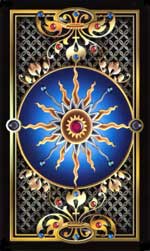
The cards themselves measure 11.7mm x 7.0mm, just a tiny bit shorter
and wider than the usual Lo Scarabeo size. They are not large
format cards, which means they are easy to shuffle for those with less
than moose sized hands. The backs have an interesting star and
scroll work design, which for those with a serious AR complex about
reversibility, is not reversible, although you have to look closely to
notice (look carefully at the edges of the red jewel in the center, or
the little blue things in the cross-quarter positions). The cards
have a semi-gloss coating which is very slippery. The brightly
colored artwork is framed in gold and set against a black background,
giving it a glowing appearance somewhat reminiscent of the Yeager
deck. The two extra cards depict the Celtic Cross and a “Daily
Spread.”
The arrangement of the deck follows the “standard” Golden Dawn - RWS
format of 22 major arcana, usual suits in the minor arcana, and court
cards of page, knight, queen and king. It was the artist’s stated
intention to create a deck based on the RWS so that, “Most users would
therefore be immediately familiar and comfortable with it.”
(Quoted from the Artist’s Notes section in the accompanying
book.) Mission accomplished -- well, sort of. The artist
further states: “I would make it visually attractive . . . and
incorporate a number of personal touches to insure the deck’s character
was unique and not merely another Rider-Waite clone.” It’s that
last bit that makes all the difference in the world.
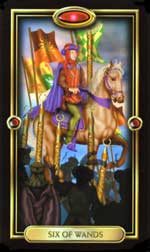 See, a Tarot card means what it means not by
virtue of any memorized
keywords, nor by association with a bunch of silly psycho-babbleisms,
nor by signification -- that a card has some pre-attached meaning like
a skull-and-crossbones on a bottle signifies poison. A card has
meaning at all by virtue of symbolization -- because of what it draws
out of the reader. The meaning doesn’t come from the cards; it
comes from you, and the cards are tools for drawing forth the
impressions and ideas that form themselves into a meaning. Tarot
cards are what Stanley Fish calls “self-consuming artifacts” -- the
meaning arises from its interaction with your own mind, to the point
that the imagery of the card just fades into the background, as the
imagery it draws out of your own mind takes over. If that is
true, then the artwork is everything, because it is the artwork that
stimulates the imagination and creates the participatory relationship
with the consciousness of the reader that transforms ink on a card into
philosophical and metaphysical import.
See, a Tarot card means what it means not by
virtue of any memorized
keywords, nor by association with a bunch of silly psycho-babbleisms,
nor by signification -- that a card has some pre-attached meaning like
a skull-and-crossbones on a bottle signifies poison. A card has
meaning at all by virtue of symbolization -- because of what it draws
out of the reader. The meaning doesn’t come from the cards; it
comes from you, and the cards are tools for drawing forth the
impressions and ideas that form themselves into a meaning. Tarot
cards are what Stanley Fish calls “self-consuming artifacts” -- the
meaning arises from its interaction with your own mind, to the point
that the imagery of the card just fades into the background, as the
imagery it draws out of your own mind takes over. If that is
true, then the artwork is everything, because it is the artwork that
stimulates the imagination and creates the participatory relationship
with the consciousness of the reader that transforms ink on a card into
philosophical and metaphysical import.
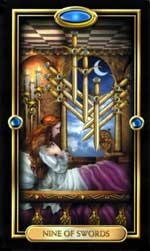
That’s why I qualified the
“mission accomplished” above with “sort
of.” First, it is true that many Tarot decks are produced not so
much for divination and fortune telling, as for education and practice
in some particular metaphysical or esoteric system, the original RWS
being among them. In that case, meanings do come pre-assigned,
and the intent of the imagery is to call to mind specific associations
of meaning within the system. The Gilded Tarot, at least from my
impressions of it, does not well serve the purpose of instructing one
in Waite’s understanding of the Golden Dawn version of the Bavarian
Illuminati’s interpretation of the medieval alchemist’s rendition of
the ancient Hebrew Cabala. For that I am grateful in the
extreme. Second, it is also true that for divinatory purposes
there must be a resonance, or “sympathetic vibration,” between the
imagery of the card and one’s own
consciousness. Put another way,
the cards must not only be artistically attractive, but they must in
some sense “speak to,” enchant, or otherwise interest the mind of the
reader. Without that connection, which is not entirely on a
conscious level, there will be no imagination and no meaning. If
you prefer the imagery of the original RWS, then you may find
the Gilded Tarot quite alien. On the other hand, if you find the
original RWS imagery dull and boring,
then the Gilded Tarot may be just the gateway your Sepher-Sephiroth
imprisoned psyche has been awaiting.
For here, in the Gilded Tarot, the imagination and talent of the artist
have run wild with the traditional imagery; it is the traditional Tarot
gone mad with creative genius. In many of the cards, it is as if
someone left the door open, and the little creatures of the forest have
invaded and enlivened the dusty icons of the old tradition, while in
others, mysterious machines that might have been used by Captain Nemo
to navigate the Nautilus both fascinate and challenge the mind to look
within and see without. The frequent juxtaposition of
earth-oriented imagery with a hint of New Age spirituality brings this
deck to life like no other, and should be a welcome cathartic for a
Tarot community that has become seriously constipated with
“interpersonal relationships” and “discovering personalities.”
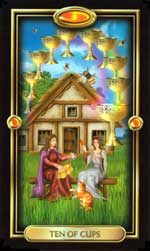 Which brings us to the book.
This is primarily a review of the
deck, and as I said, the deck is worth the price alone. Any book
which purports to tell you the meanings of the cards, or how to read
them, runs seriously afoul of the above articulated principles of
symbolic participation and self-consuming artifacts. Granted, one
needs a place to start, something to orient the mind to what the deck
is all about, and the book accompanying the deck is as good for that as
any. But do leave it at that. Don’t fall into the trap of
assigning meanings to the cards in the way the author does, or
believing that because the author says a card tells you this or that
about your personality, that it’s either true about you or about the
card. It is true about the author and what the cards stimulate
the author to see, and that’s that.
Which brings us to the book.
This is primarily a review of the
deck, and as I said, the deck is worth the price alone. Any book
which purports to tell you the meanings of the cards, or how to read
them, runs seriously afoul of the above articulated principles of
symbolic participation and self-consuming artifacts. Granted, one
needs a place to start, something to orient the mind to what the deck
is all about, and the book accompanying the deck is as good for that as
any. But do leave it at that. Don’t fall into the trap of
assigning meanings to the cards in the way the author does, or
believing that because the author says a card tells you this or that
about your personality, that it’s either true about you or about the
card. It is true about the author and what the cards stimulate
the author to see, and that’s that.
I am a philosopher and metaphysicist; my interests are primarily in
cosmology and consciousness. Hence, I read and interpret the
Tarot in terms of understanding how the universe is put together, how
and why it does what it does, where it is going, and what its
relationship to human consciousness may or may not be. I’m not
interested in meddling in personal or interpersonal affairs, and
therefore do not read or use the cards in those ways. Others do,
and that is fine, if that is the direction in which the cards -- and
not the “experts” -- take you. This also means that I am a little
more sympathetic to the idea of the Tarot as a means of “fortune
telling” than most, and not the slightest bit concerned with what the
Tarot “ethicists” -- who seem to have no problem with practicing
psychoanalysis without qualification or license -- have to say
about it. That is, with one very important reservation. A
Tarot reading is a participatory event in a probabilistic universe, by
which I mean that a reading is a combination of conscious, unconscious,
and external factors, intertwined with events that follow general
trends and not rigid mathematical laws. Hence, the Tarot is much
better at revealing forces and trends in general terms, than it is at
giving specific answers to specific questions. It is much more useful
to keep in mind the general principle, “If you stick your hand in the
fire, you will get burned,” than it is to ask whether or not you should
put your fingers in any particular flame.
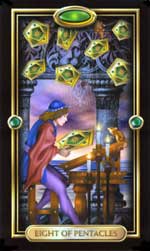
To be effective in this way, a Tarot deck needs to have a rich
symbolism upon which to draw, and imagery that fascinates, enchants and
enlivens the consciousness of the reader. For that purpose, the
Gilded Tarot is one of the best available. Even if you feel
little sympathy to the often dry and dull tradition out of which its
images originally emerged, the artist has taken the deck far beyond the
limitations and restrictions of any particular set of meanings and
interpretations. As such, this deck should be well received by
those of many backgrounds and beliefs. It may well be the very
best Tarot for the beginner, for instead of having to choose one
specific set of meanings, the student can pretty much learn from the
cards themselves. “Go to the cards, thou sluggard, and learn
their ways.” Even if you aren’t a sluggard, and particularly with
this Tarot, it is a good idea to rely more on your own interpretations
than to worry about memorizing someone else’s.
Here are some suggestions. First, take a look through the deck,
just to get an idea of what the cards themselves look like. Then,
separate out the 22 cards of the Major Arcana from the rest; these are
the cards bearing Roman numerals at the top. Many readers
consider the Major Arcana to be indicative of forces, changes, or major
events about to take place. Notice that some of the cards seem to
compliment each other, such as the Emperor and Empress, while others
lock horns with each other, such as the Devil and Temperance.
Others, like the Tower, seem to stand (or fall) alone, while the Sun,
Moon, Star and Universe seem to form a progression of sorts. Ask
yourself what these cards, and their relationship to each other, might
mean. Some diviners prefer to include the four Aces with the
Major Arcana since they, too, symbolize powerful forces. Note
also that many, when learning the Tarot, start by reading the Major
Arcana alone, and then progress later to the whole deck.
Take a look at the Minor Arcana, which consists of four suits of ten
numbered cards plus four court cards each. The suits in most
Tarot decks are Wands, Cups, Swords, and Pentacles. The numbered
cards of the Minor Arcana are often taken to mean specific situations
or events, while the court cards may refer to persons, human actions,
or human-caused situations. Notice the general color scheme of
the different suits; many think of the suits as representing the
“elemental” forces of Fire for wands, Water for cups, Air for swords,
and Earth for pentacles. There is a great variety of
interpretation as to what those elemental forces mean, and how those
meanings play out in the cards, so there is no “right” or “wrong”
interpretation. Lower numbered cards generally refer to
beginnings, middle cards to progress and obstacles, and higher numbered
cards to completions, or lack thereof.
Now you can take a look at the book, and see what the author has to say
about the meanings of the cards. But only look; read it as
suggestions, not Biblical commandments. In fact, you might want
to take a look at several different books, before deciding what system
of interpretation, if any, suits you best. You should also, by
this time, have started a notebook on your cards; one of those
hard-cover bound books works nicely, but be sure there are enough pages
for at least one page for each Minor Arcana card, and at least three
pages for each Major. You will want additional pages for general
notes, and for designing your own layouts.
Which brings us to what most people really want to know -- how does one
actually read the cards? There are many different “spreads” or
“layouts” that readers use, and most readers eventually design their
own layout, sometimes using different layouts for different kinds of
reading. Some layouts, like the Celtic Cross, which is covered in
the book that comes with the cards, assign specific meanings to cards
that appear in each location. I have difficulty with this kind of
layout, because my general chaotic view of the universe teaches that
the order the cards are drawn in is less important than the general
pattern in which they appear. I prefer to read cards by what is
sometimes called “dignification”, which in general terms means
understanding the meaning of the cards by how they relate to the cards
around them, rather than worrying too much about which card is in which
spot.
The layout I prefer, and which works well with a symbolically rich deck
like the Gilded Tarot, is a triangular shaped pattern. First,
four cards are drawn and placed at the base. These are the Earth
cards, and refer to foundations; they may be situations or events in
the past or present, major changes that have occurred or are about to
occur, forces coming into play, or even general trends in the way
things are going, given past history and present circumstances.
The Earth is the foundation of all our knowledge and actions; it may be
as stable as a rock or as violent as a storm, but it is still the
ground upon which we stand. Once the cards are placed, see if
they tell a story or come together in some identifiable pattern or
meaning. I should mention here that readings sometimes don’t
work; they seem to say nothing but gibberish. That is not
unusual. It’s like turning the dial on your radio and then
turning it on; sometimes you get a station, sometimes you get one in a
language you can’t understand, and sometimes you get just static.
Readings have the same problems, and if the cards seem to be nothing
but gibberish or disconnected nonsense, it’s entirely possible that the
situation is just that, and you need to reshuffle and start over.
If the Earth cards seem to tell a story or convey some kind of meaning,
then you are off to a good start. Now, draw three more cards, and
place them above the Earth cards. These are your Sun cards, and
while they may specifically refer to the passage of time, or to ideas
and thoughts in consciousness, more generally they indicate transitions
-- changes of situation, mood, ways of loooking at things, or actions of
forces and persons. Next, lay out two cards above the Sun.
These are the Moon cards; they are cards of the future, of hidden
forces, unseen changes, and maybe unexpected persons and unintended
consequences. One might be a Dark Moon and the other a Bright
Moon, but that depends on the cards. Finally, place one card at
the top. This is the card of the Stars; it is the card of the
vast and the impersonal, so don’t take it too personally. It may
indicate a general trend, an overall picture, a piece of advice,
or it just might be a “fortune cookie”, referring to a specific
outcome. The important thing is to understand how all the cards
fit together into a general picture, and this might even require
altering the way you interpret individual cards. Use your
imagination and insight; they are far more important in this kind of
reading than remembering keywords.
Notice I didn’t mention, “Think of a question,” or anything like
that. It is usually better to approach the Tarot, at least in
this type of reading, without any particular question or preconceived
purpose in mind. Let the Oracle speak as it will. Wisdom is
not necessarily what you expect it to be; you will learn something from
each reading and, in the long run, it might be the thing you think
least important that will some day prove invaluable.
In conclusion, the Gilded Tarot by Ciro Marchetti, available from
Llewellyn, is not only an outstanding addition to the range of decks
available today, but a significant revitalization and redefinition of
what the Tarot is, and what it can be. It is an excellent deck
for the beginner, the experienced reader, and the collector. For
those interested, the artist’s
web site offers not only a hand made
version of the deck, but also additional artwork, some related to the
deck and some not, that are every bit as fascinating as the deck
itself.
Back to home page.


 And now, we have the Gilded Tarot,
by Ciro Marchetti. “Welcome To
An Ancient World Of Magic And Wonder,” proclaims the box in which the
deck comes. Yes indeed, welcome to the mystery, beauty, and
wonder that the Tarot is and always should have been.
Finally, a deck conceived and executed by an artist with the
imagination to see within the tradition what its founders never saw,
and the talent to present images that are enchanting and inspiring --
images that provoke, rather than subdue, imagination and
curiosity. If I were going to teach the Tarot, this is the deck I
would use, no contest.
And now, we have the Gilded Tarot,
by Ciro Marchetti. “Welcome To
An Ancient World Of Magic And Wonder,” proclaims the box in which the
deck comes. Yes indeed, welcome to the mystery, beauty, and
wonder that the Tarot is and always should have been.
Finally, a deck conceived and executed by an artist with the
imagination to see within the tradition what its founders never saw,
and the talent to present images that are enchanting and inspiring --
images that provoke, rather than subdue, imagination and
curiosity. If I were going to teach the Tarot, this is the deck I
would use, no contest.
 See, a Tarot card means what it means not by
virtue of any memorized
keywords, nor by association with a bunch of silly psycho-babbleisms,
nor by signification -- that a card has some pre-attached meaning like
a skull-and-crossbones on a bottle signifies poison. A card has
meaning at all by virtue of symbolization -- because of what it draws
out of the reader. The meaning doesn’t come from the cards; it
comes from you, and the cards are tools for drawing forth the
impressions and ideas that form themselves into a meaning. Tarot
cards are what Stanley Fish calls “self-consuming artifacts” -- the
meaning arises from its interaction with your own mind, to the point
that the imagery of the card just fades into the background, as the
imagery it draws out of your own mind takes over. If that is
true, then the artwork is everything, because it is the artwork that
stimulates the imagination and creates the participatory relationship
with the consciousness of the reader that transforms ink on a card into
philosophical and metaphysical import.
See, a Tarot card means what it means not by
virtue of any memorized
keywords, nor by association with a bunch of silly psycho-babbleisms,
nor by signification -- that a card has some pre-attached meaning like
a skull-and-crossbones on a bottle signifies poison. A card has
meaning at all by virtue of symbolization -- because of what it draws
out of the reader. The meaning doesn’t come from the cards; it
comes from you, and the cards are tools for drawing forth the
impressions and ideas that form themselves into a meaning. Tarot
cards are what Stanley Fish calls “self-consuming artifacts” -- the
meaning arises from its interaction with your own mind, to the point
that the imagery of the card just fades into the background, as the
imagery it draws out of your own mind takes over. If that is
true, then the artwork is everything, because it is the artwork that
stimulates the imagination and creates the participatory relationship
with the consciousness of the reader that transforms ink on a card into
philosophical and metaphysical import.
 Which brings us to the book.
This is primarily a review of the
deck, and as I said, the deck is worth the price alone. Any book
which purports to tell you the meanings of the cards, or how to read
them, runs seriously afoul of the above articulated principles of
symbolic participation and self-consuming artifacts. Granted, one
needs a place to start, something to orient the mind to what the deck
is all about, and the book accompanying the deck is as good for that as
any. But do leave it at that. Don’t fall into the trap of
assigning meanings to the cards in the way the author does, or
believing that because the author says a card tells you this or that
about your personality, that it’s either true about you or about the
card. It is true about the author and what the cards stimulate
the author to see, and that’s that.
Which brings us to the book.
This is primarily a review of the
deck, and as I said, the deck is worth the price alone. Any book
which purports to tell you the meanings of the cards, or how to read
them, runs seriously afoul of the above articulated principles of
symbolic participation and self-consuming artifacts. Granted, one
needs a place to start, something to orient the mind to what the deck
is all about, and the book accompanying the deck is as good for that as
any. But do leave it at that. Don’t fall into the trap of
assigning meanings to the cards in the way the author does, or
believing that because the author says a card tells you this or that
about your personality, that it’s either true about you or about the
card. It is true about the author and what the cards stimulate
the author to see, and that’s that. 